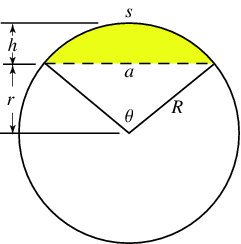This is the equation for finding area of Trapezium
A=1/2(a+b)h
or
A=h/2(a+b)
The arc length is equal to (formula)
l=θ /360*2π r
Volume of a prism is
A*l
(area of the cross section)
Volume of a sphere
A=4πr3
A rectangle has sides 5 cm by 7 cm. Find
a) It's area
b) It's perimeter
A=5*7=35 cm2
P=2*(5+7)=24 cm
Area of a equilateral triangle with sides 4 cm
a=1/2*b*h
height = 3.46 cm
a= 0.5*4*3.46
=6.92 cm2
area of circle with radius 7.5 cm... Leave π in the answer
a=π r2
a=π *(7.5)2
a=56.25π
Volume of a cube when sides are 5 cm by 6 cm by 8 cm
V=LWH
=5*6*8
=240 cm3
Surface area of a cube when sides are 4 cm by 6 cm by 10 cm.
SA=2(lb+bh+lh)
=2(4*6+4*10+6*10)
=2*124
=248 cm2
Pythagoras Theorem? (formula)
a2+b2=c2
What is the difference between the area of a square with sides 3 cm and a rectangle with sides 3 cm by 2 cm?
A of square: 3*3=9 cm2
A of rectangle: 3*2=6 cm2
9-6=3cm2
Find the yellow shaded area when r=6cm and
θ =70o
A=πr2θ/360 - (0.5*sinθ)
=π*36*70/360-(0.5*sin70)
=22-0.5
=21.5 cm2
Find the volume of a hemisphere with radius 5 cm.
V=4/3*πr3
=4/3*π*125
=523.6/2
=261.8 cm3
Find the slant height of a cone of curved surface area 20 cm2 and radius of 3 cm.
SA= π*r*l
20=3π*l
l=2.12 cm
Area of segment of a circle? (formula)
A= Area of sector - Area of triangle
Find the area of a trapezium with parallel sides of 20 cm and 5 cm and a height of 10 cm
A=h/2(a+b)
=10/2(20+5)
=5(25)
=125 cm2
Find the arc length of which subtends an angle of 140o at the centre of a circle of radius 12 cm. You could leave π.
Al= 140/180*12π
=12π*0.78
=9.33π
pyramid: equilateral triangular base of side= 7 cm, height= 14 cm
A=1/2*7*14
=49 cm2
V=49*7
=343 cm3
Find the height of a solid cylinder of radius 1 cm and total surface area of 28 cm2.
TSA=2πrh+2(πr2)
28=2πh+2π
h=4.46 cm-1
h=3.46 cm
Total surface area of a cone (formula)
TSA= πrl + πr2
Parallel sides a=14 cm, b=20 cm and the area is 119 cm2. Find the height.
A= h/2(a+b)
119=h/2(34)
119=17*h
h=7 cm
How far is a chord of length 15 cm from the centre of the circle of radius 10 cm?
102-7.52=b2
100-56.25=b2
b=6.61 cm is the answer
A cone is attached to a hemisphere of radius 5 cm. If the total height of the object is 15 cm, find its volume. You may leave π in your answer.
V= (4/3*π*125)/2
=83.33π
V= π*250/3
=83.33π
Total V= 83.33π + 83.33π
=166.67π
Find the surface area of a sphere of volume 28 cm3
r=1.89 cm
SA= 4*π*1.892
=44.9 cm2
The diagonals of a parallelogram are 12 cm and 27 cm. What is:
a) its perimeter
b)its area
a) P= 2*(12+27)
=78 cm
b) A= 12*27
=324 cm2